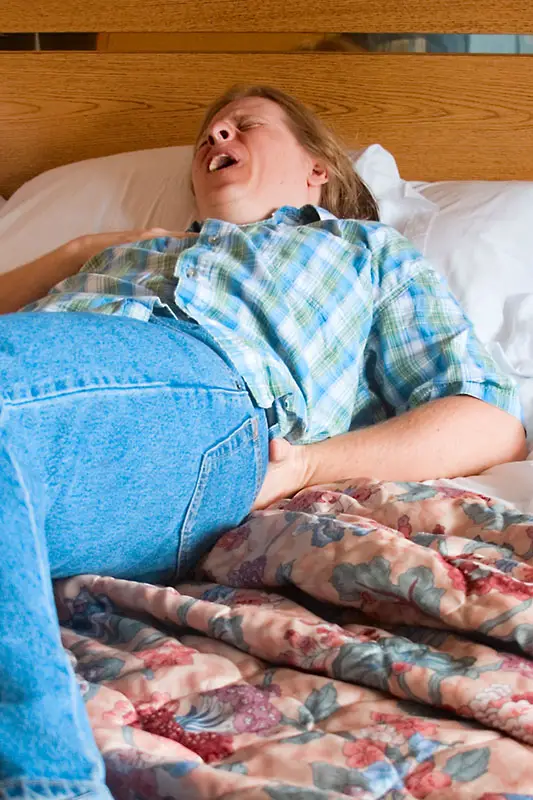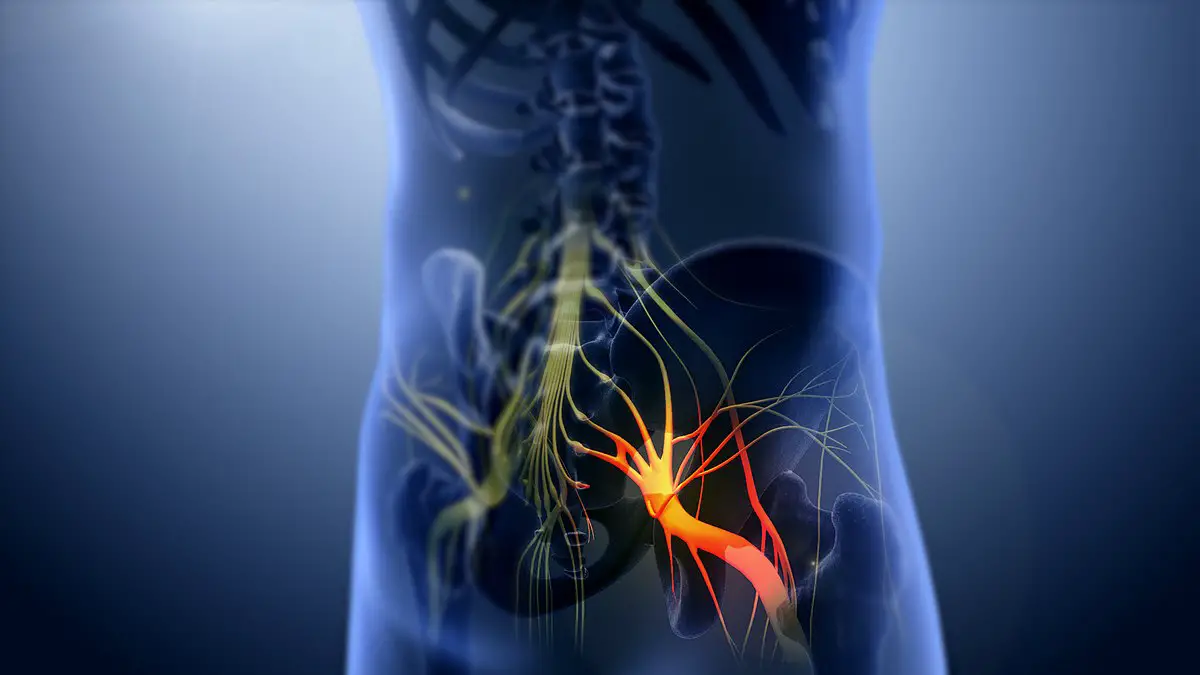La lumbosciatica is a pathology characterized by lower back pain that radiate to the lower limb. Although most often benign, the lumbosciatica can be the cause of many symptoms that have a significant impact on the patient's activities, particularly professional ones.
Furthermore, it is not uncommon for lumbosciatica to develop following occupational exposure to certain contributing factors such as the manual carrying of heavy loads, the use of vibrating machines or the prolonged maintenance of certain positions.
Risky jobs, duration of work stoppage, recognition conditions as occupational disease… In this article, we will look at some professional aspects full lumbosciatica.
Lumbar vertebral column: some notions of anatomy
The lower part of our spineCalled « lumbar spine » ou « Lumbar spine », consists of 5 vertebrae voluminous separated by intervertebral discs.
Each vertebrate lumbar consists of a bulky block of bone called « vertebral body », of a fine bony blade behind called « spinal blade » ou "posterior arch" and a space between these last two structures called "vertebral foramen".
The stacking of vertebrae lumbar spine and their vertebral foramina form a bony tunnel called "lumbar canal". The latter is crossed by the terminal part of the spinal cord.
La spinal cord lumbar gives rise to numerous nerve roots which anastomose to form a complex network of nerves called "lumbosacral plexus".
The latter, in turn, gives rise to a large-caliber nerve (the most voluminous in the human body) called « sciatic nerve ».
Le nerf sciatica, with its different nerve branches, is intended for the sensory and motor innervation of the entire lower limb.
Lumbosciatica: what is it?
When the sciatic nerve, or one of the nerve branches that form it, is compressed or irritated by any pathological process (hernia, tumour, infection, etc.), pain appear along the entire path of the latter, i.e. the buttock, thigh, leg until pied (different route depending on the nerve root concerned).
This condition is called a « neuralgia sciatica », better known by the general public under the name « sciatica ».
If lower limb pain is accompanied by low back pain (pain in the lower back), we will no longer speak of sciatica, but of lumbosciatica. To simplify : lumbosciatica = sciatica + low back pain !
Lumbosciatica: Definition and management
What are its causes ?
In the vast majority of cases, the lumbosciatica are secondary to a disco-radicular impingement, a pathological interaction (compression, irritation) between a intervertebral disc and a lumbar nerve root.
This is usually a herniated disc lumbar which compresses or irritates one of the nerve roots forming the sciatic nerve (particularly at the L5-S1 level).
Other rarer causes of sciatica exist:
- Lumbar osteoarthritis: Inflammation of the posterior spinal joints, caused by osteoarthritis, can diffuse and irritate a nerve root causing sciatica. Compression of a nerve root can also be caused by an osteophyte (bone growth observed during osteoarthritis).
- La lumbar stenosis : a narrowing of the spinal canal at the lumbar level can compress the spinal cord and its nerve roots, causing pain in the lower limbs and lower back (lumbosciatica), as well as other neurological symptoms of variable intensity (which can go paralysis of the lower limbs).
- A tumor process: a benign or malignant bone tumor can compress a nerve root and cause lumbosciatica.
- An infectious process: a spondylodiscitis, i.e. an infection of the intervertebral disc and vertebral bodies adjacent, can irritate one or more lumbar nerve roots and cause lumbosciatica.
- A vertebral fracture : a displaced bone fragment from a fractured lumbar vertebra may compress one or more nerve roots.
How does it manifest?
La lumbosciatica is manifested by two main symptoms: low back pain (lumbar pain) and sciatica (pain in the path of the sciatic nerve, that is to say along the lower limb).
These pains have the following characteristics:
- They are increased by cough, sneezing, straining to defecate…anything that raises the pressure inside the abdominal cavity.
- They are sometimes accompanied by sensitivity disorders in the lower limb or genital area (tingling, numbness, electric shocks, etc.). Extreme pain, deemed unbearable by the patient, may be observed. This is called the hyperalgesic lumbosciatica.
- They are sometimes accompanied by motor disorders such as muscle weakness in the lower limb which can go as far as paralysis in the most severe cases. We will thus speak of paralyzing lumbosciatica.
- They are triggered or accentuated by certain maneuvers, in particular the Lasègue maneuver during the clinical examination.
In the case of lumbosciatica secondary to a cancerous process (malignant bone tumor), the usual symptoms may be accompanied by weight loss, An loss of appetite, An chronic fatigue and / or a deterioration of general condition.
A fever can also be observed, orienting more towards an infectious origin.
Lumbosciatica: work limitations
The pains of lumbosciatica can limit certain gestures and positions, in particular prolonged standing or sitting, anterior flexion of the trunk, the manual carrying of heavy loads, the use of certain vibrating machines, etc. These limitations can significantly harm the patient's professional activity, which which ends with a decrease in productivity, a increase de absenteeism and the multiplication of work stoppages.
If you have a paralyzing lumbosciatica (accompanied by paralysis of the lower limb(s)) or hyperalgesic lumbosciatica, a emergency care is necessary.
Lumbosciatica: work stoppage
In the case of lumbosciatica, a work stopping prescribed by a doctor may be necessary. The duration of the latter depends on several parameters, in particular:
- La causes lumbosciatica (herniated disc, benign or malignant tumor, spondylolisthesis...).
- La severity of symptoms.
- La response to medical treatment (an extension of the work stoppage is possible in the event of an insufficient response).
- Le the land, that is to say age of the patient, his antecedents and his general state of health.
The duration of sick leave in the event of lumbosciatica also depends on the type of profession practiced. Here are some examples (according to the high health authority):
- Sedentary work (no carrying heavy loads, office work for example): Usually 2 days off work.
- Light physical work involving the occasional carrying of a load of less than 10 kg or the repeated carrying of loads of less than 5 kg: 5 days.
- Moderate physical work involving the occasional carrying of a load of less than 25 kg or the repeated carrying of loads of less than 10 kg: 21 days.
- heavy physical work involving the carrying of loads of more than 25 kg: 35 days.
In some situations, a professional redeployment may prove necessary (impossibility of carrying out the tasks related to the position occupied).
Sciatica: recognized as an occupational disease?
La lumbosciatica is recognized as an occupational disease under certain conditions. The latter are specified in tables 97 and 98 of the general scheme relating to chronic conditions of the lumbar spine:
- Lumbosciatica must last at least 3 months to be considered chronic.
- La exposure time must be at least 5 years (period during which the patient performs work likely to cause lumbosciatica).
- Le pick-up time is fixed at 6 months, that is to say that lumbosciatica must be observed within 6 months of stopping exposure.
- The diagnosis must be made by a doctor after carrying out an imaging examination (MRI or scanner) highlighting the lumbar disc herniation (L4-L5 or L5-S1).
In the event of sciatica from a cause other than a herniated disc, recognition as an occupational disease is more complicated. In any case, it is essential toTalk to your attending physician or occupational physician so as not to lose certain rights.
Resources
References
[1] R. Thurel, “Lombosciatica by herniated disc”, Acta neurochir, flight. 2, no 1, p. 9‑31, March 1951, doi: 10.1007/BF01406095.
[2] “Rachialgia”. https://www.ameli.fr/medecin/exercise-liberal/memos/arrets-travail-referentiels-duree/rachialgies (accessed August 29, 2022).
[3] A. Petit and Y. Roquelaure, “Discal pathology and occupational disease”, Journal of Rheumatism monographs, flight. 81, no 1, p. 52-56, 2014.
[4] A. Nicot and P. Nicot, “Chronic low back pain and sick leave Cross-patient/doctor perspectives”, Medicine, flight. 2, no 4, p. 180-182, 2006.
[5] “Test Tables | AtouSante”. https://www.atousante.com/tableaux-test/?dl_cat=1&dl_search=sciatica (accessed September 1, 2022).
My name is Katia, I am specialized web editor in writing medical articles. Being passionate about medicine and writing, I set myself the goal of making medical information accessible to as many people as possible, through the popularization of even more complex scientific concepts.








